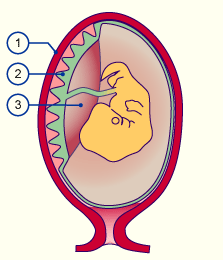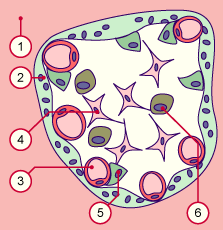|

|
|
|
10.7 The various placenta types
|
|
|
|
The development of the human placenta can be better understood by comparison with other placental forms that are encountered in mammals.
One can classify the allanto-chorial placenta according to various criteria:
- the outer form
- the type of connection = interdigitation between the maternal and embryonic tissues
- the type and number of the layers that separate the maternal and embryonic bloods
- the geometrical relationship of the maternal and embryonic blood streams with each other in the placenta. (This will not be discussed in this chapter.)
|
|
|
Among other things, the contact surface between maternal and embryonic tissue determines the amount of bidirectional materno-fetal transport of substances. The simple apposition between the chorion and the uterine mucosa obviously is not enough for a sufficient substance exchange. This is why a contact surface enlargement via some sort of interdigitation develops.
In humans it is limited to a surface that is mostly circular in shape. One speaks therefore of a discoid placenta.
|
|
Fig. 53 - Discoid placenta |
|
Legend |
|

1
2
3
|
Uterine musculature
Chorion
Discoid placenta |
|
|
|
Fig. 53
In the human placenta the exchange contact surface is restricted to a discoid region.
|
Feto-maternal interdigitation
|
|
|
|
The limited contact surface between mother and child, as occurs with a discoid placenta, is compensated by an intensive interdigitation between the two surfaces. In humans one finds the villus placenta that is constructed out of a highly complex system of interdigital folds (septa). The septa are thin, long and branched. The section comprised between two septa is called a cotyledon. Since in a human placenta these septa do not divide up the placenta completely, one also speaks of the pseudocotyledon in the human placenta.
|
|
|
| Fig. 54 - Pseudo-cotyledon placenta |
|
Legend |

1
2
3
4 |
Decidual tissue
Syncytiotrophoblast
Cytotrophoblast islands
Septum |
|
|
|
Fig. 54
The villi that make up the feto-
maternal interdigitation are incompletely separated in cotyledons. This is why this kind of placenta is termed a
pseudo-cotyledon placenta.
|
Feto-maternal separation layers
|
|
|
The materno-fetal and feto-maternal exchange processes, such as diffusion, carrier transport, active and vesicular transport are influenced by the thickness of the separating tissue layers.
They form the placental barrier.
|
|
Fig. 55 - Hemo-chorial placenta |
|
Legend |
|

1
2
3
4
5
6
|
Intervillous space
Syncytiotrophoblast
Extraembryonic mesenchyme
Fetal capillaries
Cytotrophoblast
Hofbauer macrophages |
|
|
|
Fig. 55
In a hemo-chorial placenta the villi, which are bounded by the syncytium, swim in maternal blood.
|
|
For this reason one distinguishes among three types of placentas:
- Epithelio-chorial placenta (swine, horse)
- Endothelio-chorial placenta (dog, cat)
- Hemo-chorial placenta (human, rodents, primates)
On the fetal side fetal vessel endothelium, villus connective tissue, and trophoblasts are thus always present. On the maternal side these vary. Either the entire uterine epithelium or only the maternal vessel endothelium is intact or, as in humans, both are absent.
|
|
|
Summary:
The human placenta is allanto-chorial (the chorial placental circulation is connected with the fetal allantois), hemo-chorial, discoid, pseudo-cotyledon (the villi are grouped and incompletely separated by walls that are between them), and decidual*.
* a placenta that takes part of the uterine mucosa with it when it is expulsed is decidual (decidua).
|
|
|
|
|
|
|

